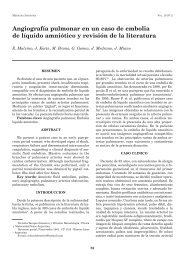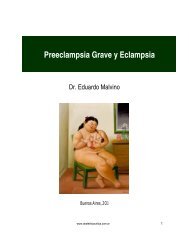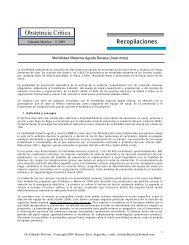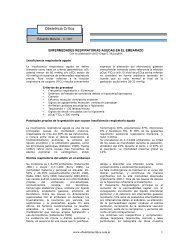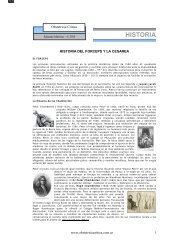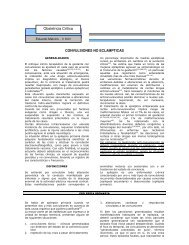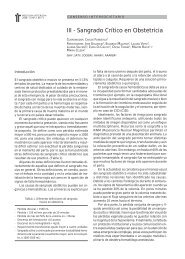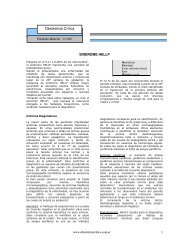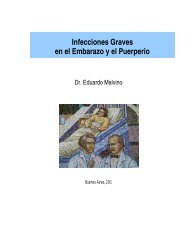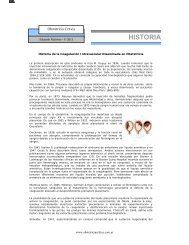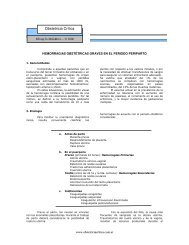edema and dystocia in labor. Treatment options are very limited. CASE: A 33-year-old woman with spina bifida and a history of multiple intraabdominaloperations and extensive intraperitoneal adhesions was admitted in labor at36(6/7) weeks' gestation with an irreducible cervical prolapse. The cervicalprolapse was reduced by topical application of concentrated magnesium sulfate.CONCLUSION: In active labor, a prolapsed cervix that is enlarged andedematous can be managed with a topical concentrated magnesium solution toprevent cervical dystocia and lacerations.J Reprod Med. <strong>2008</strong> Jan;53(1):65-6.Expectant management of uterine incarceration from an anterior uterinemyoma: a case report.Rose CH, Brost BC, Watson WJ, Davies NP, Knudsen JM.Department of Obstetrics and Gynecology, Mayo Clinic College of Medicine, 200First Street, SW, Rochester, MN 55905, USA. rose.carl@mayo.eduBACKGROUND: Uterine incarceration is an infrequent complication of pregnancyin the early second trimester. Although imaging can be confirmatory, thediagnosis is made primarily on clinical grounds, and definitive treatment involvesmanual reduction to restore the proper anatomic position. Except for preexistinguterine retroversion, often this event is idiopathic. CASE: A 30-year-oldprimigrávidas presented at 15 weeks' gestation with uterine incarceration.Manual replacement was unsuccessful. Spontaneous resolution occurred at 20weeks, followed by uneventful pregnancy. The patient underwent a classicalcesarean section at term due to fetal malpresentation. CONCLUSION: Uterineincarceration may be managed conservatively, with a favorable outcome.Obstet Gynecol. <strong>2008</strong> Feb;111(2 Pt 2):577-9.Preoperative magnetic resonance imaging and antepartum myomectomy ofa giant pedunculated leiomyoma.Alanis MC, Mitra A, Koklanaris N.Department of Obstetrics and Gynecology, Carolinas Medical Center, Charlotte,North Carolina, USA. mca3@musc.eduBACKGROUND: Antepartum myomectomy is reserved for severe pain andprevention of fetal complications. Magnetic resonance imaging has been usefulin nonpregnant women for preoperative management and patient counseling.CASE: A primigrávidas was admitted at 12 weeks of gestation in severe acuteabdominal pain with a large abdominal mass, confirmed by magnetic resonanceimaging to be a pedunculated 30x27x19-cm uterine leiomyoma. Anuncomplicated abdominal myomectomy was performed, incorporating a flat cupvacuum device to mobilize the mass without disturbing the gravid uterus. Thepatient later had an uncomplicated term vaginal delivery and healthy newborn.CONCLUSION: Magnetic resonance imaging and a flat cup vacuum device werehelpful in preoperative planning and performing an uncomplicated abdominalmyomectomy during pregnancy, respectively.Obstet Gynecol. <strong>2008</strong> Feb;111(2 Pt 2):575-7.
Abetalipoproteinemia complicating the puerperium.Palmer AB, Knudtson EJ.Department of Obstetrics and Gynecology, University of Oklahoma HealthSciences Center, Oklahoma City, Oklahoma 73190, USA. Andrea-Palmer@ouhsc.eduBACKGROUND: Abetalipoproteinemia is a rare, autosomal recessive disease, inwhich the absence of beta-lipoprotein results in the malabsorption of fat-solublevitamins. There are few reported complications from abetalipoproteinemia duringpregnancy. We present a case of untreated abetalipoproteinemia complicatingthe puerperium. CASE: A 23-year-old, gravida 3, para 0020 woman presented toan outside facility in labor, and her delivery was complicated by postpartumhemorrhage and a large vulvar hematoma. She was coagulopathic andtransferred for suspected disseminated intravascular coagulation. Her preexistingmedical history was not appreciated by the transferring facility. CONCLUSION:Abetalipoproteinemia in pregnancy is rare. Untreated disease conveys multisystemorgan dysfunction and has ramifications in labor and delivery. Cliniciansmust elicit a comprehensive medical history to properly manage complications inthe puerperium.Obstet Gynecol. <strong>2008</strong> Feb;111(2 Pt 2):573-5.Late postpartum hemorrhage due to von Willebrand disease managed withuterine artery embolization.Salman MC, Cil B, Esin S, Deren O.Department of Obstetrics and Gynecology, Hacettepe University Faculty ofMedicine, Ankara, Turkey. csalman@hacettepe.edu.trBACKGROUND: Von Willebrand disease is the most common inherited bleedingdisorder caused by quantitative or qualitative defects of von Willebrand factor,which may lead to postpartum bleeding problems. In such patients, resistantpostpartum hemorrhage may be treated effectively by using transcatheter arterialembolization. CASE: Life-threatening late postpartum bleeding of a patient withvon Willebrand disease type 3 unresponsive to traditional medical approacheswas successfully managed with selective uterine artery embolization.CONCLUSION: Selective transcatheter uterine artery embolization may be usedto control life-threatening pelvic hemorrhage unresponsive to traditional localmeasures. Such an intervention may also be used successfully in patients withbleeding disorders as the last chance of uterine preservation.Obstet Gynecol. <strong>2008</strong> Feb;111(2 Pt 2):565-9.May-Thurner Syndrome resulting in acute iliofemoral deep vein thrombosisin the postpartum period.Zander KD, Staat B, Galan H.Department of Obstetrics and Gynecology, University of Colorado HealthSciences Center, Denver, Colorado, USA.BACKGROUND: May-Thurner Syndrome is a congenital anomaly of the rightiliac artery, which causes an acquired narrowing defect in the left iliac vein. Theartery abnormally compresses the vein causing intraluminal collagen deposition
- Page 1 and 2: Obstetricia CríticaEduardo Malvino
- Page 3 and 4: gestational age at delivery, Apgar
- Page 5 and 6: Maternal risk factors associated wi
- Page 7 and 8: exclusive categories: 1) bleeding r
- Page 9 and 10: Division of Obstetrics and Gynecolo
- Page 11 and 12: as uncommon as primary synovial sar
- Page 13 and 14: Cardiac Troponin I Elevation After
- Page 15 and 16: significant increase in carbohydrat
- Page 17 and 18: of one per 1500 pregnant women. Cal
- Page 19 and 20: Background: To investigate the rela
- Page 21 and 22: PowerLab hardware unit and Chart v3
- Page 23 and 24: Prophylactic antibiotics for the pr
- Page 25 and 26: years old (n = 23,921). Univariate
- Page 27 and 28: five women uses FDA C, D and X drug
- Page 29 and 30: and complicated. CONCLUSION: Irresp
- Page 31 and 32: clinically effective. Nevertheless,
- Page 33 and 34: Obstetrics and Gynecology Departmen
- Page 35 and 36: Pregnancy-induced severe gestationa
- Page 37: penicillin or ampicillin, whereas 3
- Page 41 and 42: case of acute abdominal pain, abdom
- Page 43 and 44: Callaway LK, Lawlor DA, McIntyre HD
- Page 45 and 46: ketoacidosis during induction of la
- Page 47 and 48: and low platelets (HELLP) syndrome.
- Page 49 and 50: Division of Reproduction and Endocr
- Page 51 and 52: simulation center, and to teamwork
- Page 53 and 54: significantly associated with psori
- Page 55 and 56: episiotomy and prophylactic oxytoci
- Page 57 and 58: ecent obesity epidemic has had a pr
- Page 59 and 60: guidelines in 2002. However, the di
- Page 61 and 62: need for intensive neonatal care, h
- Page 63 and 64: mEq/l) metabolic acidosis. Other et
- Page 65 and 66: Acta Obstet Gynecol Scand. 2008;87(
- Page 67 and 68: etrospective review of pregnancies
- Page 69 and 70: Maternal obesity and pregnancy comp
- Page 71 and 72: interval 3.78-5.30) and severe obst
- Page 73 and 74: of GDM. Methods: 1,662 pregnant wom
- Page 75 and 76: Registers. POPULATION: All pregnant
- Page 77 and 78: J Reprod Med. 2008 May;53(5):365-8.
- Page 79 and 80: egarding cervical cancer screening
- Page 81 and 82: College of Surgeons in Ireland, Dub
- Page 83 and 84: maternal morbidity has increased bo
- Page 85 and 86: increased uterine activity was rela
- Page 87 and 88: options.Journal of Perinatology adv
- Page 89 and 90:
atio, 1.73; 95% CI, 1.11-2.69). Thi
- Page 91 and 92:
discharge at site of perineal repai
- Page 93 and 94:
Thirty-one other patients refused t
- Page 95 and 96:
Department of Obstetrics and Centre
- Page 97 and 98:
developed any new problems. CONCLUS
- Page 99 and 100:
It seems to be safe to continue bre
- Page 101 and 102:
colonization in a subsequent pregna
- Page 103 and 104:
Crude and adjusted odds ratios were
- Page 105 and 106:
the subsequent development of ESRD.
- Page 107 and 108:
Acta Obstet Gynecol Scand. 2008 Sep
- Page 109 and 110:
OBJECTIVE: To investigate pregnancy
- Page 111 and 112:
OBJECTIVE: To compare the perinatal
- Page 113 and 114:
exceptionally rare. CASE: A 23-year
- Page 115 and 116:
CONCLUSION: This case demonstrates
- Page 117 and 118:
peripartum hysterectomy included ce
- Page 119 and 120:
BMJ. 2008 Sep 8;337:a1397. doi: 10.
- Page 121 and 122:
Lancet. 2008 Sep 17. [Epub ahead of
- Page 123 and 124:
Obstet Gynecol. 2008 Oct;112(4):951
- Page 125 and 126:
Additionally, the effects of distur
- Page 127 and 128:
analyzed. Initial echocardiographic
- Page 129 and 130:
pathologic or anatomically anomalou
- Page 131 and 132:
Eur J Obstet Gynecol Reprod Biol. 2
- Page 133 and 134:
chorioamnionitis; and (3) in contra
- Page 135 and 136:
underlying conditions related to st
- Page 137 and 138:
third trimester of pregnancy.BMJ. 2
- Page 139 and 140:
Texas Health Science Center, Housto
- Page 141 and 142:
preterm birth before 34 weeks (P
- Page 143 and 144:
cases. Most patients (91%) received
- Page 145 and 146:
Ultrasound Obstet Gynecol. 2008 Nov
- Page 147 and 148:
Maggard MA, Yermilov I, Li Z, Magli
- Page 149 and 150:
Clinical and Population Health, Per
- Page 151:
the biologic mechanism is unclear,



